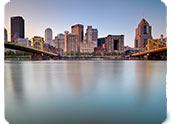WELCOME TO PITTSBURGH
Welcome to Pittsburgh, one of the most dynamic and inspiring places in the world. Here you will find a robust mix of history, technology, culture and community pride. This unique blend of features, coupled with an unparalleled quality of life, has made Pittsburgh a city of distinction.
Pittsburgh is a city steeped in history. As a point of strategic importance, the confluence of the Allegheny, Ohio and Monongahela rivers was once the site of Fort Pitt, the largest, most elaborate British outpost constructed in North America. Incorporated as Pittsburgh in 1816, the surrounding settlement grew rapidly as travelers passed through bound westward. In the mid 1800s, the economy boomed as Pittsburgh became an industrial hub. Natural gas, coal and oil were abundant in the area, while the accessibility of the three rivers made Pittsburgh a natural center for manufacturing. By the 1870s, Pittsburgh had been proclaimed the “Forge of the Universe,” turning out one-half of all the glass and iron produced in the United States. Over time, the focus of manufacturing shifted to the steel industry and Pittsburgh became the “Steel Capital of the World”—as well as a powerful economic leader. Pittsburgh’s industry peaked during World Wars I and II.
With heavy manufacturing came pollution and other problems. In the late 1940s, Mayor David Lawrence, philanthropist Richard King Mellon along with many other civic and corporate leaders joined in one of the nation’s first urban renewal programs, named Renaissance I. This $500 million program included flood and pollution control, as well as downtown reconstruction and the development of Point State Park, Gateway Center and the first Greater Pittsburgh International Airport. The 1970s and early 1980s marked a time of turmoil for the city of Pittsburgh. Pittsburgh’s economy began a rapid shift as the domestic steel industry began to decline, leading eventually to collapse.
Unemployment soared to 14.7 percent, retirees of many mills lost their pensions, and many residents moved out of the region in search of employment opportunities. Renaissance II, a $3 billion urban development program, began during this time period as an effort to rebuild.
During this decade of transformation, the David L. Lawrence Convention Center, the light rail system and seven shopping complexes, including Station Square, were opened. Pittsburgh Plate Glass erected their “Gothic castle of glass,” a distinctive feature of the downtown skyline today. Through the administration of civic and corporate leaders, along with the effort of dedicated citizens, Pittsburgh has built upon existing strengths in medicine, technology and education to reestablish not only the economy, but its position as a world leader.
Today, Pittsburgh is considered a proto-type for a city in transition. No longer a city of endless smokestacks, the mills that once lined the riverbanks have been leveled to make way for new businesses. Modern research centers and firms involved in advanced technology employ over 150,000 people. Pittsburgh has 29 four year colleges and universities with a total enrollment of over 100,000 students. Pennsylvania State University is ranked among the 15 largest in the nation. In addition, there are over 70 vocational and trade schools located within city limits.
The health care industry is equally strong—University of Pittsburgh Medical Center (UPMC) performs more operations than any other hospital in the U.S. One organ transplant is performed every 24 hours in Pittsburgh, and Allegheny University Hospital was the first in the nation to use Magnetic Resonance Imaging (MRI). The renowned Children’s Hospital of Pittsburgh has been recognized as one of the nation’s top five hospitals for children.
The entertainment industry is growing as well; Pittsburgh’s natural topography and wide variety of unique architecture have made it an appealing production site for movies, television series pilots and commercials. Box office hits filmed here include Silence of the Lambs, Robocop, Striking Distance, The Awakening and the remake of Night of the Living Dead. The city Charles Dickens once called “hell with the lid off” has been renamed “America’s Most Livable City” and the “Third Best City for Business” by Rand McNally and Fortune magazine. Beaver County, with the lowest crime per capita of anywhere in the nation, was recognized as one of the “Safest Places in America” by the F.B.I.
Lifestyle
Pittsburgh has world class culture. The Carnegie Center, in its “noble quartet” of art, science, music and literature, is known nationally as second only to the Smithsonian. The Carnegie Museum of Natural History has over 10,000 objects on display at any given time and is home to one of the largest dinosaur collections in the world. Over 200 performing arts groups, as well as scores of museums, concert halls and galleries are in the area.
Pittsburgh abounds with varied recreation. Pro sports include: hockey, baseball and football (the Pittsburgh Steelers were the first NFL team to win four Super Bowls.) For those who would rather play than watch, outdoor recreation is abundant. Open areas and riverfront parks are common. There are over 26,000 boat registrations in Allegheny County—second in the nation only to Dade County, Florida. There are more trees within Pittsburgh’s city limits than any other metropolitan area in the country.
Nowhere else will you find such diversity in living. Nowhere else will you find such quantity and quality in art, music, recreation, history or technology—and housing you can afford. Here you will find an ideal blend of metropolitan amenities combined with suburban comforts. Pittsburgh is the perfect place to call home —Welcome!

